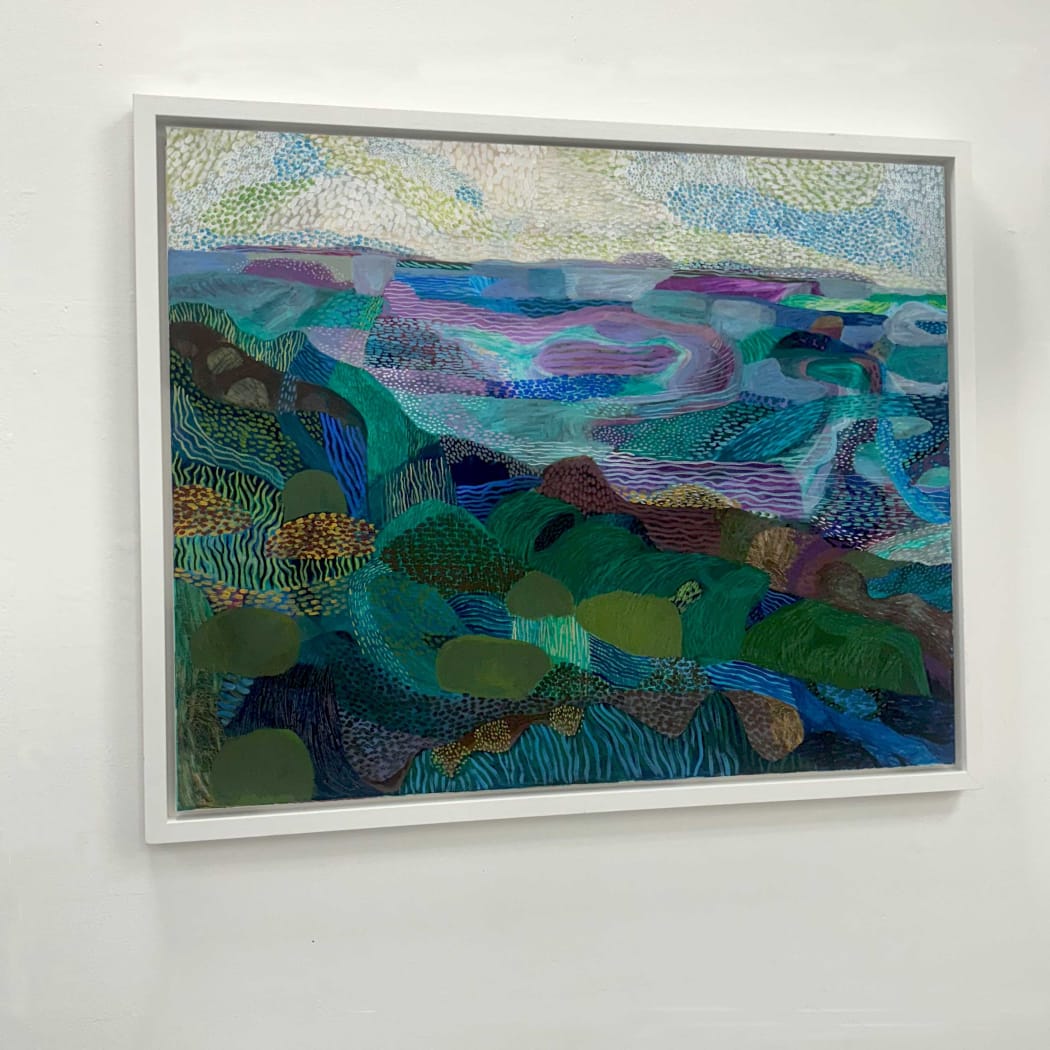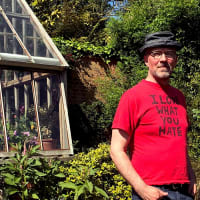
Installation in the Shakespeare Barn by Linda Jamieson Murmuration 2024
Leading the way into their subject matter among the painters are Simon Carter, Caroline Mackintosh, Mary Blue, and Linda Jamieson, who describe differing stretches of the eastern coastline, depicting the marshes and the indeterminate areas where the land gives way to water using a more intense palette. Their approach to colour makes apparent their strong sensory and emotional connection to what they observe.

Simon Carter (left) A Map of The World, (right) Field Notes 2021
Simon Carter has been walking a particular stretch of Essex coastline for many years, near his family's farm. He frequently presents his canvases in two panels. These two paintings are presented for the viewer to be read together and represent opposing points of view. Seen together they bracket his vision and experience traveling through this familiar territory, as sky becomes ground and water translates to air.

Mary Blue (left) Birch Trees , (right) Birch Trees Four Seasons 2024
Mary Blue has been recording the shifting coastal elements along the coast near Wells in Norfolk in paint and writing her response to what she sees on each canvas. Her priorities change as the seasons change. Sometimes Mary's subjects are trees (in this case groups of Silver Birch), other times it is the nature of the water itself, as it laps gently on the shore or as it crashes against the soaked shingle. In these smaller paintings the written evidence of attachment to her surroundings all but disappears. And yet there is a sense of the moment, the paint's physical application is vital - liquid, applied urgently a little like a storyboard for a film. Each small canvas contains all that is needed. it has a job to do and it has to do it convincingly, without excess.

Caroline Mackintosh (left) Summer Camping Fields II, (right) Walk to the Beach II Covehithe 2024, and large herringbone basket by Karen Bek 2024
Caroline Mackintosh is based close to the resort of Southwold on the Suffolk coast. She has worked for several decades in education, teaching art as well as training teachers in delivering other subjects. She has re-kindled her career as an artist in the last three years, exhibiting within the East Anglian region since taking a break from teaching. And although she describes herself as being 'self-taught', she studied to foundation level at Norwich Art School (now Norwich University of the Arts) before shifting her interest from the arts to the humanities by going on to a BA in Development Studies at the University of East Anglia. Throughout her journey she has always maintained her interest in art, while raising her family in Ireland and embarking upon her teaching career.
Perhaps because it has taken a while for Caroline to decide to paint more, her canvases seem to be more consistently realised to a really high standard. There is an obvious sense of purpose as well as an attention to detail in the surfaces she creates, which are loaded in detail and yet open and fascinating. She uses mixed media along with photographs and her own memories, to develop both smaller works and her larger canvases in acrylic and cold wax. The process enables her to explore her colour palette, which is intense, with paint flatly applied using masked-off areas. Her canvases are filled with texture and the patterns she finds in Suffolk and Norfolk's coastal areas that reveal something of these transient areas that has not been recorded before.

Linda Jamieson installation (four from top left clockwise) - Field, Dune, Marsh, The Edge, and on its own Creek 2024, James Evans, Conch 2021
Painter Linda Jamieson has had a career as a textile designer, but has been making her distinctive paintings for more than a decade now. Her colourful canvases are a visualisation of her emotional inner 'landscape' and not of a particular geographical location on the coast, where her studio is in north Norfolk. However, the wind patterns, bird-life, clouds, pools and reeds present in her immediate locality are embedded within her visual lexicon that perfectly describes something of her internal monologue.
There are a second group of painters, who have had a different response to the landscape, who have also looked at the coast, but also, further inland. These are Lorraine Bewick, Eileen Coxon and Peter Wylie. They all three use a more muted palette than the first group. They represent different aspects of the landscape by painting what others have missed, or focussing upon a particular light you get on the eastern shore, that has captured their attention for years.

Lorraine Bewick installation - (top left) Stiffkey, (below left) Hunstanton Cliffs, and (right) Low Tide Snettisham 2024, and a handblown vase -Dawnmist - by Stewart Hearn 2024
Lorraine Bewick has been painting the sense of place she finds unique to the indeterminate area of The Wash, where mud and marshland meet the sea. She has a quietly radical approach to painting. Her subject is really a distillation of the sensation of what she sees, which is frequently indefinable. Her canvases vary in size and ambition. Great expanses of sky can be encapsulated on a surface measuring just 20 x 40 cm. While other views may seem to depict nothing more tangible than a certain light, with chiffon-like veils of paint across a surface of more than a metre across. Her paintings when they hit the mark are so impressive in their technical and emotional subtlety.

Peter Wylie installation - (left) North Sea Studies #14,#16, and (right) Taylor and Green One 2019
Peter Wylie paints the suffolk coast, near where he grew up in Lowestoft. He has recorded the coastal defences on that coast and produced a set of etchings of the remaining structures. For this exhibition he has contributed four of his immaculate small canvases of the coast, which have a different sensibility. They are beautifully realised, technically and visually. Two depict views down the shore at Benacre and Covehithe, both identifiable Suffolk locations. The two smaller studies are of views that look out across the North Sea, painted using a muted palette. These are the latest of an ongoing series each one numbered, rather than having a location name. The viewer looks out to sea. Peter's father was a fisherman, and these studies are reminders of this firsthand familial connection to the sea. They are contemplative and beautifully observed.
The larger canvas depicts a single storey row of public housing, built in 1973 for agricultural workers in Ditchingham, near Bungay, on the Norfolk/Suffolk border. This painting is representative of another aspect of Peter's work. He has had a long-term interest in celebrating the brief and unashamedly optimistic modernist period of British architecture, at its most utilitarian, aesthetically pleasing, and arguably, socially useful. Designed by Lowestoft-based architects Tayler and Green, what is a modest housing scheme, a single row of bungalows, was one of the last commissions their practice designed before the pair retired. They had long careers re-building Great Yarmouth and Lowestoft after the bomb damage that had occurred during WWII, and were a couple. Peter uses these opportunities to reveal the stories behind buildings like these, that would otherwise become untraceable. Tayler and Green were award-winning in what they achieved as Lowestoft-based architects who gained a national reputation through their work. An achievement that deserves to be celebrated. The row of little houses sit beautifully in the landscape to this day and have influenced subsequent developments immediately adjoining them.

Eileen Coxon installation - (left to right) Spring Greening, Daydreaming April, Field Trials 2024
Eileen Coxon has been painting the area along the Suffolk and Norfolk border, including in the Waveney Valley, for many years. It is where she has lived for several decades. She does not paint like anyone else. Eileen's point of view switches between pictorial composition looking across the hedgerows and fields following perspectival convention, and looking down from above on the field boundaries and buildings. The resulting paintings are a clever distillation of the two views, being both playful, as well as pleasing in their abstracted division of the canvas surface. Eileen is one of the few artists who seems content to include the large metal hangers that most large farms have built in Britain, and while ubiquitous throughout the land are completely absent in most contemporary landscape.
Lay of the Land has closed now. It was held at The Fermoy Gallery and Shakespeare Barn at St George's Guildhall 29 King Street, King's Lynn PE03 1HA.
About the author

Paul Barratt
Paul Barratt started working in contemporary art galleries in 1989, having graduated in Fine Art from Goldmsith’s, London University. He initially worked at Anthony d’Offay Gallery, one of the contemporary art dealers, who dominated the London art market in the 80s and 90s. He was approached by the Lisson Gallery to be gallery manager for the influential art dealer Nicholas Logsdail. This was followed by a short period in New York at Gladstone Gallery, to work for visionary art dealer Barbara Gladstone, working with the artist and filmmaker Matthew Barney.
On his return to London, Paul secured a place on the postgraduate curatorial course at the Royal College of Art, to complete an MA. After graduation in 2001, he worked as an independent curator on several projects in Oslo, London, Brighton and Basel, before joining Paul Vater at his design agency Sugarfree in 2004. He has worked with Paul ever since.














